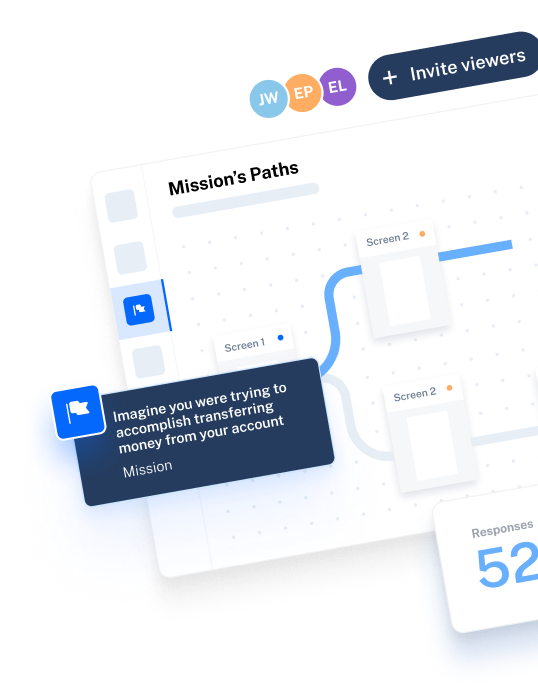Chapter 3
7 Top tree testing tools to improve navigation & UX
Tree testing is hugely effective for optimizing your website’s navigability and evaluating information architecture. But effective isn’t always the same as easy. From structuring the branches to analyzing results, tree testing can be a lengthy process that draws on your team’s resources.
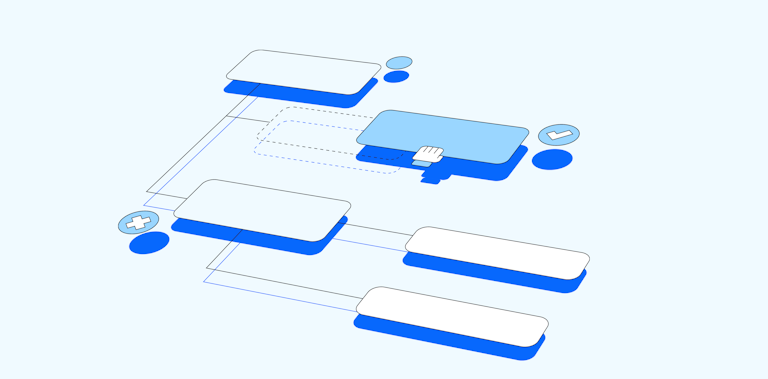
Luckily, there are many industry-leading tools out there that will streamline your tree testing process and expedite results. In this chapter, we’ll explore the top 7 options on the market:
- Maze
- Optimal Workshop
- UserTesting
- UserZoom
- Lyssna
- UXtweak
- PlaybookUX
Why do you need a tree testing tool?
Starting off, let’s look at the benefits of tree testing tools. Ultimately, a purpose-built UX research tool makes getting navigability insights from your users easier. Some main benefits of using a tree testing tool include:
- Efficiency: A tool makes it fast and easy to input your task and website’s items, meaning you’ll save time and effort
- Results analysis: Tree testing tools automatically analyze user paths and success rates based on results, which translates to a shorter time to valuable insights
- Scalable testing: Using a tool means you can test with many remote users at the same time—statistical significance, here we come!
- Participant recruitment: Preparing participants and getting your testers in a row can be resource-intensive, but many tree testing tools come with panels and recruitment features to streamline this
Not all tree testing software does all of the above, though. That’s why we made this list—so you don’t miss out on the platforms that let you collect the fruits of your user research labor.
Top 7 tree testing tools for UX research
Main benefit | Pricing | G2 rating | |
|---|---|---|---|
Maze | Maze tree testing lets you quickly structure your tree, assign tasks to participants, add follow-up questions, and automatically analyze paths and success rates. | Maze has a free trial. Tree Testing features come with a custom-built Enterprise plan, which you can trial for free to ensure they’re a fit for you. | 4.5/5 ⭐ |
Optimal Workshop | Includes automatic analysis capabilities that highlight score and user pain points based on navigation paths. | Optimal Workshop has an Individual plan for $107/month and a Teams plan for three users with custom pricing. | 4.5/5 ⭐ |
UserTesting | Sessions tabs give you access to recordings of users as they complete tree tests, which can be helpful for behavioral insights. | UserTesting offers custom pricing, with reports suggesting its median pricing is around $40,000/year. | 4.5/5 ⭐ |
UserZoom | Basic success rate measurement tells you who completed your tree and analyzes user paths. | UserZoom offers custom pricing, with sources suggesting its pricing is around $40,000/year. | 4.2/5 ⭐ |
Lyssna | Provides teams with a summary that includes overall success, time taken, and directness to help gauge overall findability. | Lyssna has a Free plan and a Basic plan at $75/month. | 4.5/5 ⭐ |
UXtweak | Lets you automatically generate a tree based on your existing website navigation. | UXtweak has a Free plan and a Basic plan at $130/month. | 4.7/5 ⭐ |
PlaybookUX | Includes a wide range of analysis options like task success, first-click, overview metrics, participant paths, follow-up question visualizations, and custom summary reports. | Pay-as-you-go option and Scale plan at $5,400/year. | 4.6/5 ⭐ |
Here’s a closer look at the tree testing UX tools on the list and how they can help you with your research project.
1. Maze
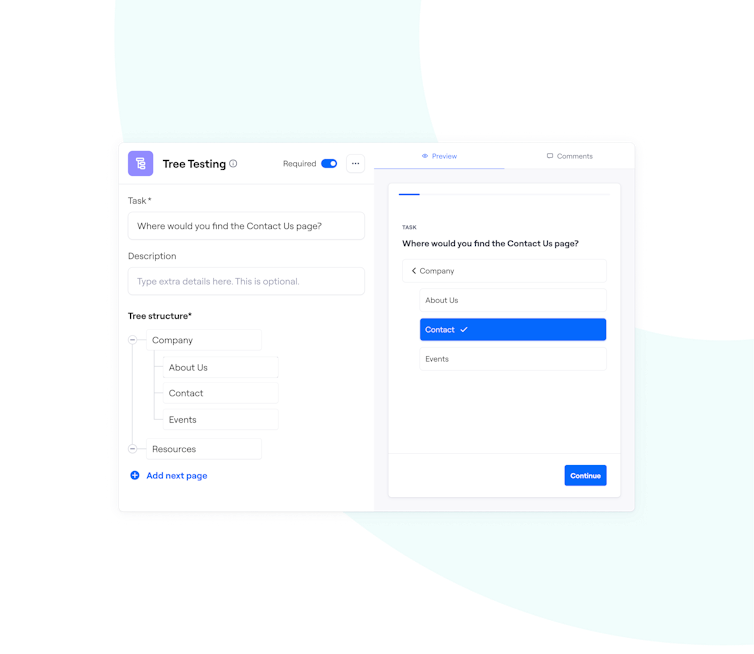
Maze is a leading user research platform that empowers UX teams to get game-changing insights with a suite of comprehensive UX research methods—including a specialized tree testing tool. With Maze’s tree testing tool, you can quickly structure your tree, assign tasks to participants, add AI-powered follow-up questions, and automatically analyze paths and success rates.
Access free templates to assess information architecture, test label clarity, and define digital taxonomy—all combined with Maze’s participant panel, intuitive analysis, and automated reporting to fast-track your research process and share insights with stakeholders.
Key features
- Intuitive Tree Testing UI: Maze makes it fast and easy to outline your website’s information architecture including parent, sibling, and child nodes
- Fast-track tree tests with templates: Maze’s library of tried-and-tested templates allow you to get up and running in a few clicks
- Follow-up questions: Maze AI allows you to ask intelligent and contextual follow-up questions based on user input
- Automated reporting and analysis: Assess success metrics like most common path, end screen, success rate and more, all packaged in a ready-to-go automated report for stakeholders
- Recruit and deploy tests in an instant: Maze Panel gives you access to over 140 filters and 130 countries to find your ideal user research participants…
- While Maze Reach lets you create a database of testers you can segment, send targeted email campaigns to, and monitor with metrics like response rates and time taken to respond
- Capture behavioral insights with Clips: Simplifies moderated testing, giving you the option to watch users’ screens and hear their thought process during think-aloud testing
Alongside tree testing, Maze also offers comprehensive moderated and unmoderated UX research methods to complement your tree testing: Maze’s user research solutions enable you to conduct Live Website Testing, Prototype Testing, Feedback Surveys, Interview Studies, Card Sorting, and more alongside your tree testing to create more holistic data stories.
Pricing
Maze offers a free trial of the platform for up to 3 studies. Tree Testing features come with a custom-built Enterprise plan.
2. Optimal Workshop
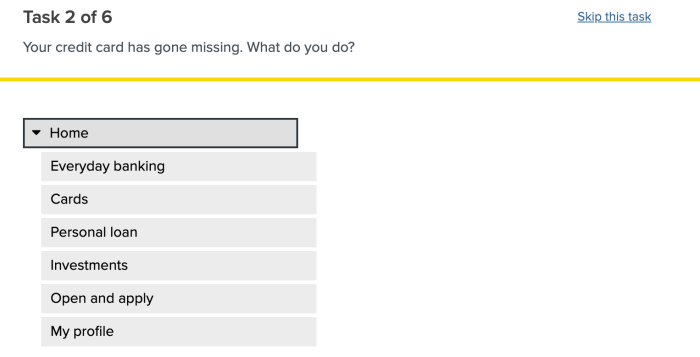
Optimal Workshop is a UX research platform that offers tree testing among other research methods. Its tree testing feature works much the same as the other tools on this list, letting product teams understand specific navigation issues users have based on the results. It also comes with a range of data visualization tools, including pie charts for user path analysis.
Key features
- Includes a simple UI for mapping out your website’s information architecture hierarchically on the tree
- Has automatic analysis capabilities that include score and user pain points based on navigation paths
- Offers participant recruitment services to help you find the right testers
Pricing
Optimal Workshop has an Individual plan for $107 per month and a Teams plan for three users with custom pricing, so it’s ideal for individual researchers or independent developers.
3. UserTesting
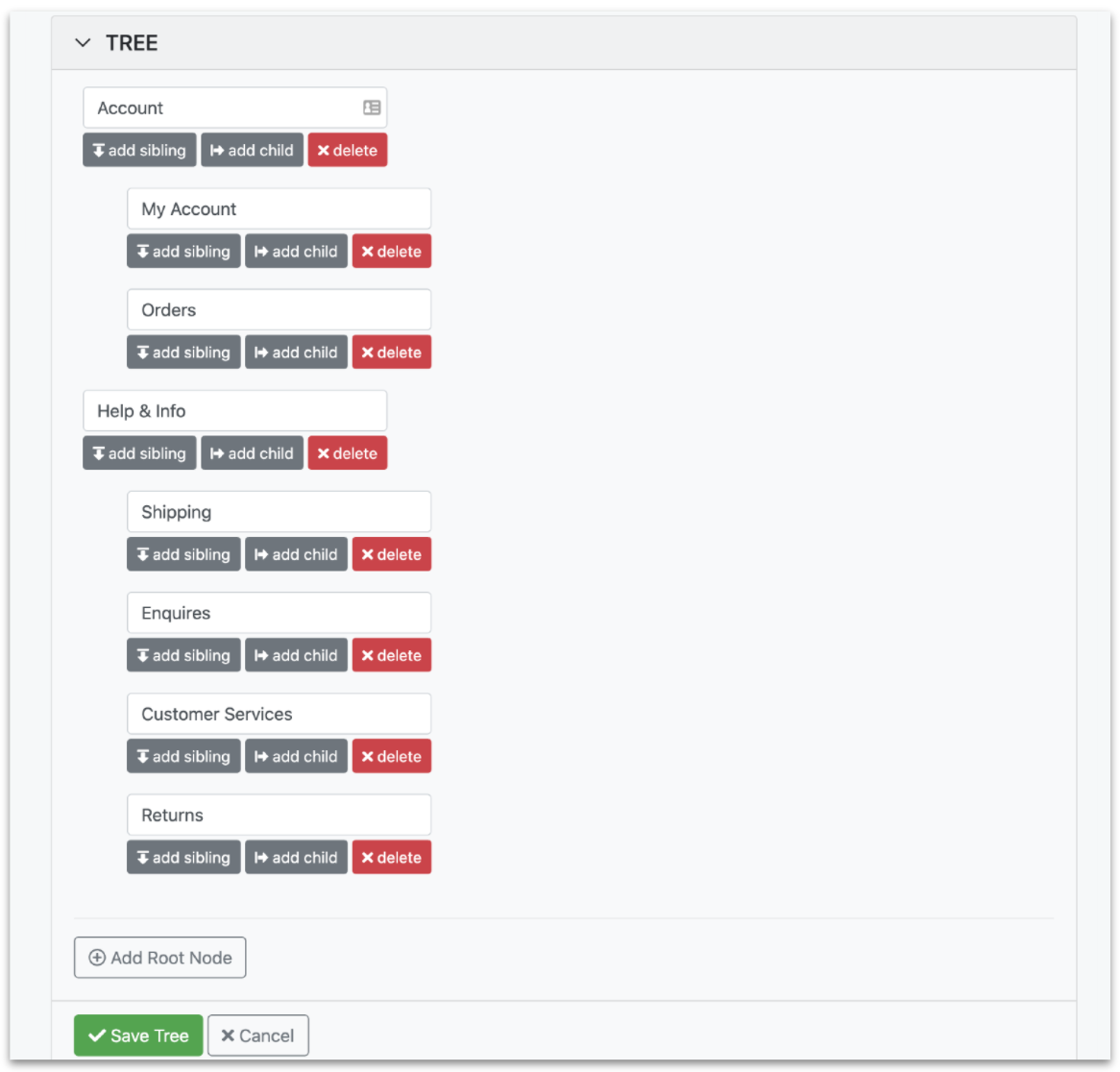
UserTesting is a UX research platform that helps you gauge your website’s navigability through tree testing. The platform offers a set testing template to structure your tree, alongside a range of analysis options.
Key features
- Tree testing template lets you structure and publish your tree test
- Teams can monitor test viewers, participants, and average completion rate
- Like Maze Clips, UserTesting sessions tabs give you access to recordings of users as they complete tree tests, which can be helpful for behavioral insights
Pricing
User testing offers custom pricing, but reports from Vendr state its median pricing is around $40,000 per year, ranging up to and over $110,000.
4. UserZoom

Built to help product teams collect research insights at scale, UserZoom offers a tree testing tool to optimize website navigability. It offers different tree types and lets users copy their website information from spreadsheets to simplify the upload process.
Key features
- Two different tree structures are available. While ‘Classic’ allows participants to jump through categories, ‘Compact’ hides subcategories as participants move through the tree
- Basic success rate measurement tells you who completed your tree and analyzes user paths
- Similar to Maze, UserZoom offers a range of usability and navigation testing tools to complement tree testing, such as card sorting and prototype testing
Pricing
UserZoom offers custom pricing, but online sources suggest its pricing matches its parent company, UserTesting—coming in at around the $40,000 mark per year.
5. Lyssna
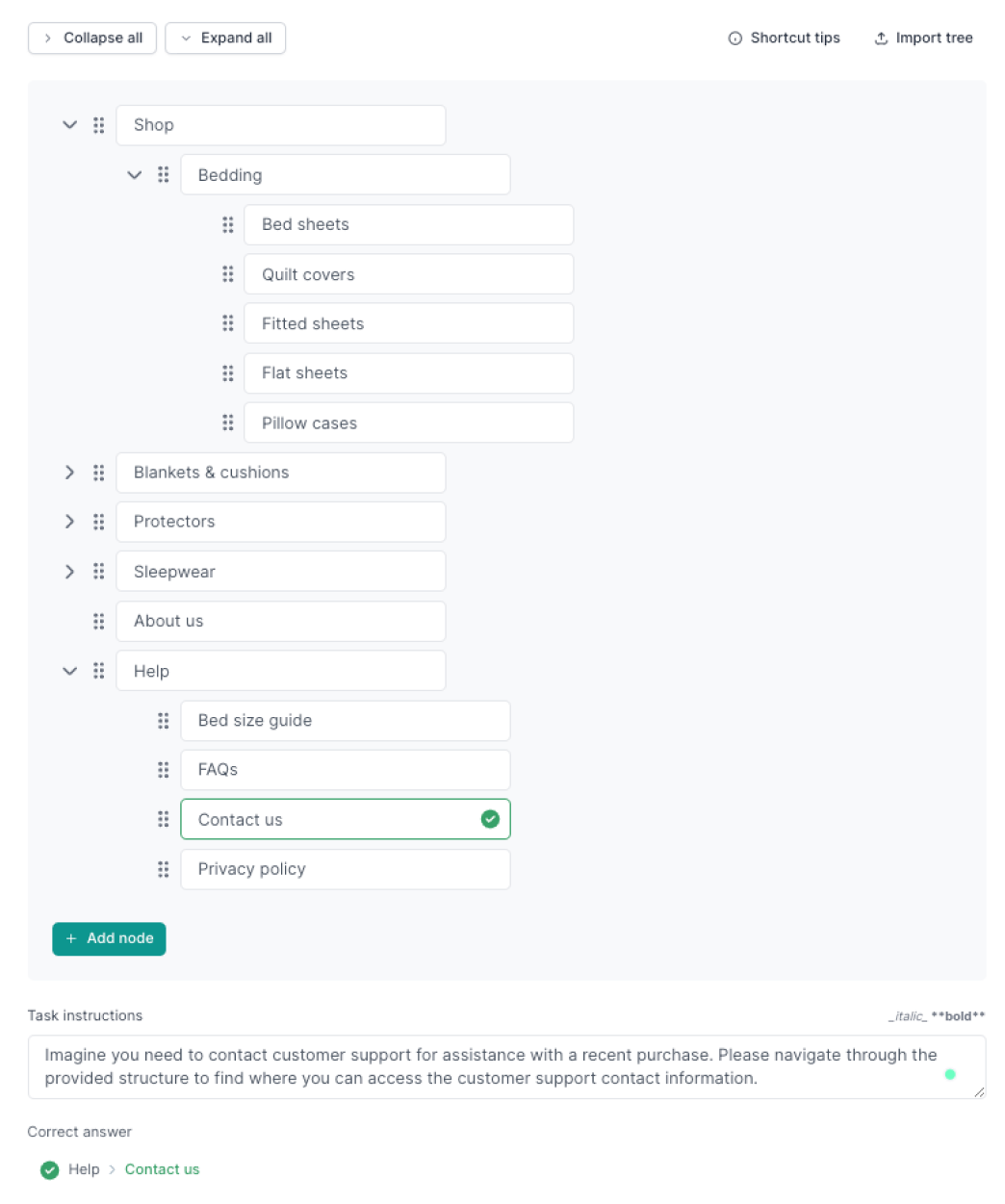
Lyssna, formerly known as UsabilityHub, is another UX research platform that lets you conduct tree testing alongside a range of other research methods. Teams can use Lyssna’s tree testing templates or upload a CSV file with their website’s information to make setting up and structuring the tree easy. This platform also has a variety of metrics to analyze results and extract insights.
Key features
- Allows for follow-up questions after tree testing is complete
- Lyssna’s panel gives users access to 35+ attributes to filter and recruit participants
- Access a results summary that includes overall success, time taken, and directness to help gauge overall findability
Pricing
Lyssna has a free plan and a Basic plan at $75 per month, with custom-priced Organization plans available too. All plans include tree testing, however it’s worth noting that the Free plan only allows for tests up to 2 minutes long, and the Basic plan limits tests to 5 minutes.
6. UXtweak
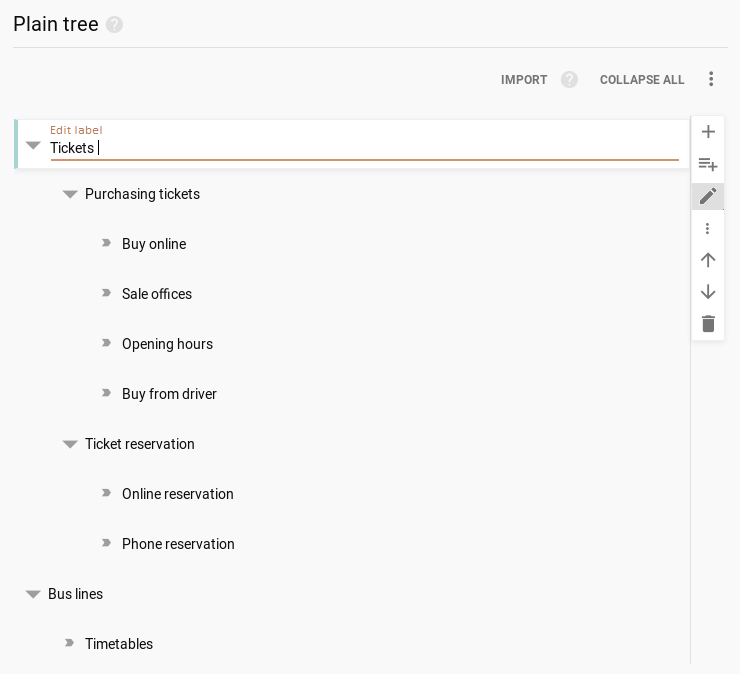
UXtweak is another research platform offering moderated and unmoderated research methods like usability testing, interviews, and tree testing. Its UI lets you quickly input categories and subcategories into your tree, deploy your tree testing study, and get quick findings. UXtweak may not offer the most extensive analysis capabilities, but it still works for streamlining tree testing, and getting actionable insights fast—so long as you’re happy to do some manual analysis.
Key features
- Lets you type in your website’s categories and subcategories or import the information from a CSV file
- Tree testing editor allows for sibling and child nodes in your trees
- Lets you automatically generate a tree based on your existing website navigation
Pricing
UXtweak has a free plan for one user, with a basic plan at $130 per month per user.
7. PlaybookUX

Amongst other UX research methods, PlaybookUX offers tree testing to optimize your website’s navigability. Most notable are PlaybookUX’s customization options, letting you change everything from your study’s welcome page to defined success paths to help speed up analysis.
Key features
- Users can record tree testing sessions to capture behavioral insights
- Allows for follow-up questions after each task to double down on insights
- Includes a wide range of analysis options like task success, first-click, overview metrics, participant paths, follow-up question visualizations, and custom summary reports
Pricing
PlaybookUX has a pay-as-you-go option with no subscription required, and a Scale plan for $5,400 per year.
How to choose the right tree testing tool
There are some important factors to consider before making your choice of tree testing tool:
- Pricing: A tool can have all the important features you need for your UX research, but you’ll quickly have to stop using it if your company can’t afford it long-term. Make sure you have an established budget for your tool before you commit—a free trial can also help test your compatibility with the tool!
- Tool suite: You might need tree testing today, but what about tomorrow? Your next UX project might require anything from user interviews to card sorting. It’s more cost-effective to have one comprehensive UX research tool for all your needs rather than buying many tools for many purposes.
- Integrations: Look for tools that can effortlessly slide in with your tech stack. Otherwise, you risk data silos and wasting time transferring data from one platform to another.
- Support: While a tool should be intuitive, that doesn’t mean you won’t need help somewhere along the way. Prioritize platforms with well-documented FAQs and a help center.
Optimize your information architecture with tree testing
Manual tree tests can work, but they take more resources, more time, and limit your testing capabilities. So if you really need momentum in your user research project, then opting for a a UX research platform which includes tree testing (like Maze 👀) can transform your process.
Plus, when using a comprehensive tool like Maze, you can conduct a wide variety of research studies using purpose-built research tools. Whether it’s tree testing, user interviews, card sorting, or more—Maze offers a holistic user experience platform.
Speaking of card sorting, we’re about to move on to the last chapter of this guide—in which we compare tree testing vs. card sorting. We’ll see you there!
Frequently asked questions about tree testing tools
What is the tree testing method?
What is the tree testing method?
Tree testing is a UX research method in which you list your website’s information architecture hierarchically in plain text. You then give participants a series of tasks and analyze if they can find the right items through the appropriate path. UX researchers use tree testing to measure a website’s navigation structure and functionality.
How many participants do you need for tree testing?
How many participants do you need for tree testing?
The number of participants you need depends on different factors, like the type of testing you are conducting, your product’s target audience, the confidence level you need, and the goal of your project. To achieve statistical significance and establish clear patterns, we recommend having approximately 50 participants complete your tree test.
How long does tree testing take?
How long does tree testing take?
It depends on the test’s complexity! Typically, tree tests last up to 15 minutes for the user. But planning, designing, deploying, and analyzing tests can take more than a week of your time. However, tools like Maze speed the process up.
What is treejack? ‘
What is treejack? ‘
Treejack’ is what Optimal Workshop previously called their tree testing feature. It’s now just called ‘tree testing’, but it’s the same solution.



